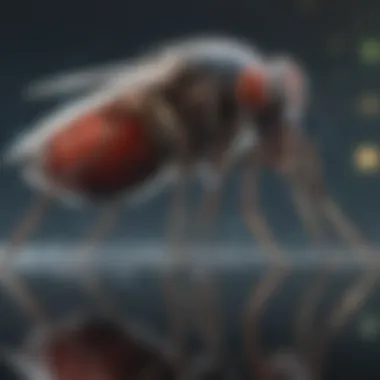Effective Strategies for Preventing Malaria Transmission


Intro
Malaria remains a significant global health challenge. Caused by the Plasmodium parasite, it is primarily transmitted through the bites of infected Anopheles mosquitoes. Understanding the life cycle of the parasite and its vectors is crucial in developing effective strategies for prevention. The persistence of malaria in various regions is influenced by several factors such as environmental conditions, socioeconomic factors, and health infrastructure.
Addressing malaria involves multifaceted approaches. From vector control to community health education, every element plays a role. The consequences of malaria impact not only individual health but also economic stability and community development. As such, reducing transmission rates can lead to substantial improvements in public health. This article will explore diverse strategies and their efficacy in malaria prevention.
Prelims to Malaria Transmission
Malaria remains a significant global health concern, with its transmission impacting millions of people, particularly in tropical and subtropical regions. The relevance of understanding malaria transmission is critical not only for public health authorities but for individuals living in affected areas. Identifying how the malaria parasite spreads provides a foundation for all prevention strategies.
Importance of Studying Malaria Transmission
The complexity of malaria transmission is tied to the interaction between the malaria parasite, the vector—Anopheles mosquitoes—and environmental factors. This article addresses how these elements intertwine, affecting the rates of infection. By comprehensively examining these factors, we can identify effective interventions aimed at breaking the cycle of transmission.
Understanding malaria transmission encompasses several areas, including:
- Parasite Behavior: Insights into how the parasite infects host organisms.
- Vector Dynamics: Knowledge of mosquito behavior and habitat preferences.
- Environmental Influences: Recognition of how climate, geography, and human activities affect transmission rates.
The benefits of focusing on malaria transmission involve enhancing prevention efforts and ultimately saving lives. Integrating effective prevention strategies, such as vector control and community-based initiatives, can significantly reduce infection prevalence. In this context, the article will discuss the underlying biology of malaria, the lifecycle of the parasite, and geographical considerations linked to risk factors.
"By understanding malaria transmission, we empower communities to take actionable steps against this preventable disease."
In summary, a thorough understanding of the dynamics of malaria transmission lays the groundwork for improving current strategies, enhancing community health programs, and focusing research on innovative solutions that can lead us closer to eradication.
Vector Control Strategies
Vector control strategies are vital in reducing the transmission of malaria. These strategies focus on minimizing contact between the malaria parasite's vectors, particularly Anopheles mosquitoes, and human populations. Effective vector control is based not only on the application of specific interventions but also on understanding environmental conditions that can facilitate or hinder mosquito breeding. It is crucial for the overall strategy of malaria prevention as it targets the problem at its source, aiming for a decline in the number of infected mosquitoes.
Insecticide-Treated Nets (ITNs)
Insecticide-treated nets (ITNs) have emerged as a fundamental tool in malaria prevention efforts. The main advantage of ITNs is their dual function. They not only offer physical protection against mosquito bites but also act as a lethal barrier to any mosquito that comes into contact with them. The effectiveness of ITNs relies on their continuous use, particularly during the night when mosquitoes are most active. Endorsements from public health organizations have improved their uptake in numerous regions, showing a measurable impact on malaria transmission rates.
Indoor Residual Spraying (IRS)
Indoor residual spraying (IRS) is another significant method for controlling malaria vectors. The process involves the spraying of insecticides on the interior walls and surfaces of homes. This strategy is effective because it targets mosquitoes when they seek refuge indoors after biting humans. The choice of insecticides for IRS must consider various factors, including the local mosquito populations and the presence of insecticide resistance. Regular monitoring can help in maintaining the high efficacy of this intervention. However, there may be challenges related to its implementation, such as ensuring adequate coverage in all affected areas.
Environmental Management
Environmental management refers to methods that aim to modify the conditions favorable for mosquito breeding and survival. This approach integrates various practices that can significantly influence the ecology around human settlements. It encompasses several targeted strategies:
Drainage of stagnant water
The drainage of stagnant water is a critical component of environmental management. Stagnant water bodies serve as breeding sites for Anopheles mosquitoes. By removing or draining these water sources, the lifecycle of mosquitoes can be disrupted. Implementing drainage ensures that these areas do not accumulate standing water. Furthermore, communities play a vital role in maintaining drainage systems as a collective effort. However, this requires ongoing community engagement and education to sustain the practice.
Management of vegetation
Management of vegetation is essential in decreasing mosquito populations. Dense vegetation provides shelter and breeding conditions that can enhance mosquito survival. Regularly trimming and controlling areas with excessive vegetation reduces potential habitats for mosquitoes. Landscaping choices in communities can also play a role; opting for plants that do not retain water can mitigate breeding opportunities. The challenge here lies in balancing vegetation management with the need for maintaining local ecosystems and biodiversity.
Use of larvicides
The use of larvicides is another strategy in environmental management. Larvicides are chemical agents used to target mosquito larvae in water bodies. They offer a targeted approach, minimizing the impact on non-target species. The effectiveness of larvicides depends on timely application and local environmental conditions. While larvicides can contribute positively to reducing mosquito populations, issues of resistance and environmental impact must also be considered. Regular assessments and adaptations to these strategies ensure their long-term viability.
Effective vector control, including ITNs, IRS, and environmental management, is a critical component of the overall malaria prevention strategy.
Personal Protective Measures
The significance of personal protective measures cannot be overstated in the fight against malaria transmission. These measures empower individuals to minimize their risk of infection while complementing community-wide interventions like vector control and vaccination. With the malaria burden often concentrated in specific geographic areas, adopting personal protective practices is essential for safeguarding both individual health and public well-being.
Use of Repellents


Repellents are crucial tools for preventing malaria since they deter mosquitoes and other biting insects. Products containing DEET, picaridin, or oil of lemon eucalyptus are widely recognized for their efficacy. To enhance protective benefits, users should apply repellents directly to exposed skin and clothing. It is essential to follow label instructions regarding reapplication and safety measures, especially for children.
Benefits of using repellents include:
- Reduced Bite Rate: Effective use lowers the chances of being bitten by infected mosquitoes.
- Increased Outdoor Safety: They allow individuals to engage in outdoor activities without significant fear of malaria.
Considerations when choosing a repellent should include the duration of effectiveness and skin sensitivity. Portable spray bottles or lotion formats make them easy to carry on trips to malaria-endemic areas.
Protective Clothing
Wearing protective clothing is another essential measure in the prevention of malaria. Loose-fitting clothing made from tightly woven fabrics can offer an additional barrier against mosquito bites. Long sleeves and pants are recommended, especially during peak mosquito activity hours in the evening and at night.
Key aspects of protective clothing include:
- Material Choice: Fabrics treated with insecticides can enhance protection and minimize exposure.
- Layering: Multiple layers of clothing can provide better defense compared to a single layer.
It's also advisable to choose lighter-colored garments since mosquitoes are attracted to darker colors. This simple adjustment in wardrobe can significantly reduce mosquito encounters.
Behavioral Modifications
Behavioral modifications play an indispensable role in malaria prevention. Simple changes in daily habits can directly influence exposure to mosquitoes. Staying indoors during peak activity periods and ensuring living environments are equipped with screens or other barriers are effective strategies.
Practices to consider include:
- Avoiding Standing Water: Eliminate or manage sources of standing water where mosquitoes breed.
- Using Fans and Air Conditioning: Such installations can deter mosquitoes from entering living spaces and reduce their activity.
Additionally, educating communities about the importance of these behaviors encourages collective success. When individuals adopt protective measures, the community as a whole also benefits.
"Empowerment through knowledge and action is crucial in minimizing malaria transmission risks."
In summary, personal protective measures are a vital pillar in malaria prevention. By using repellents, wearing protective clothing, and adopting smart behavioral practices, individuals can significantly cut down their chances of contracting malaria. These steps not only enhance individual safety but also represent a collective effort toward malaria control.
Vaccination Efforts
Vaccination plays a crucial role in combating malaria transmission. It provides unique and long-lasting solutions that can help reduce the burden of the disease. With malaria having significant impacts on public health in many regions, vaccination efforts are essential to achieving widespread immunity. Vaccines can not only protect individuals but also contribute to herd immunity, thereby reducing transmission overall.
Current Vaccines Available
Currently, the most notable vaccine available for malaria is the RTS,S/AS01 (Mosquirix). This vaccine is designed to offer partial protection against Plasmodium falciparum, the most deadly malaria parasite. Although it does not provide complete immunity, it can significantly reduce the occurrence of severe malaria cases in children. Another vaccine, called R21/Matrix-M, is in advanced clinical trials and has shown promising efficacy.
The introduction of these vaccines can lead to a shift in malaria prevention strategies. The benefits include reduced hospitalizations, lower mortality rates and decreased economic burden on communities. However, widespread usage still faces challenges, such as storage and distribution in remote areas.
Research and Development of New Vaccines
Challenges in vaccine production
The production of malaria vaccines faces several challenges. One significant aspect is the biological complexity of the malaria parasite itself. The parasite has a complex lifecycle and numerous stages, making it difficult to create a vaccine that targets all relevant forms effectively. Additionally, the need for high safety standards and thorough clinical trials adds time and cost to the production process.
This complexity makes developing a universal vaccine a beneficial yet difficult task for researchers. The emphasis is often on targeting multiple stages in the parasite lifecycle to enhance efficacy.
Future vaccine candidates
Several new vaccine candidates are being explored to improve malaria prevention. Among the candidates are those that target different parts of the parasite lifecycle beyond merozoites. Some candidates focus on creating immunity against the mosquito stage, thus preventing transmission altogether.
These new approaches could lead to significant advances in malaria control. Their unique features include more targeted action and potentially longer-lasting immunity. Advancements in technology, such as mRNA platforms, may also improve the pace of development for these vaccines. However, funding and logistical support remain critical to move these candidates from the lab to the field.
"Vaccination is a vital component in the multi-faceted approach necessary to combat malaria effectively."


The focus on vaccination efforts provides hope for the future. Combining these efforts with existing vector control strategies can create a more comprehensive approach to reducing malaria transmission.
Public Health Initiatives
Public health initiatives play a crucial role in curbing malaria transmission. They act as a bridge between scientific advancements and community practices, ensuring that effective strategies reach the people most at risk. The strengths of these initiatives lie in their multi-pronged approach that encompasses education, collaboration, and surveillance. This synergy facilitates not only immediate responses to malaria outbreaks but also fosters long-term solutions for elimination efforts.
Community Awareness Programs
Community awareness programs are essential for fostering understanding of malaria and its transmission methods. These programs aim to educate communities about preventive measures, symptoms, and the importance of seeking treatment. Effective communication using local languages can augment understanding. One of the key benefits of these programs is the empowerment of local leaders and health workers. When communities take ownership of their health, the adherence to recommendations like using insecticide-treated nets and engaging in vector control increases.
The integration of local customs in awareness initiatives also enhances relevance. For example, educational drives can include how cultural practices may promote or inhibit malaria spread. Engaging community members through workshops or forums allows for discussions on challenges they face in implementing preventive measures. By creating a dialogue, programs also build trust between communities and health authorities, which is beneficial for the overall effectiveness of malaria control initiatives.
Collaboration with NGOs and Government Agencies
Collaboration between non-governmental organizations (NGOs) and government agencies is vital for the success of malaria prevention programs. NGOs often have the flexibility to pilot innovative approaches and mobilize resources quickly, while government agencies provide regulation and public health infrastructure. This collaboration allows for the pooling of resources, expertise, and funding, which can amplify the impact of malaria interventions.
Effective partnerships also enhance data sharing and research opportunities, critical for understanding local malaria dynamics. Through joint efforts, initiatives can be more responsive to community needs. Additionally, NGOs can act as intermediaries, engaging with communities and facilitating education efforts, while governments can ensure that contributed programs align with regional health strategies.
Monitoring and Surveillance Systems
Monitoring and surveillance systems are indispensable for tracking malaria transmission and assessing the impact of interventions. These systems gather, compile, and analyze data related to malaria cases, vector populations, and environmental factors. Improved surveillance enables health authorities to identify hotspots and allocate resources effectively.
The significance of technology in surveillance cannot be underestimated. Mobile applications and digital tools can enhance data reporting and streamline information flow. Furthermore, real-time data collection supports prompt decision-making, allowing for targeted responses and interventions. Regularly updated surveillance also informs public health policies by providing evidence of what strategies are effective.
Continuous monitoring of malaria trends and interventions can lead to safety nets for community response strategies, ensuring that during outbreaks, resources can be rapidly mobilized.
Role of Technology in Malaria Prevention
The integration of technology into malaria prevention strategies represents a pivotal shift in how public health initiatives combat this disease. With malaria affecting millions globally, the utilization of innovative technological solutions plays a major role in enhancing prevention methods. Technology not only supports traditional approaches but also opens new avenues for improved outcomes in malaria transmission control.
Mobile Health Applications
Mobile health applications, commonly known as mHealth apps, have gained prominence in improving health management in malaria-affected regions. Such apps facilitate real-time data collection and dissemination, empowering health workers and communities. They can provide crucial information on malaria symptoms, treatment options, and preventive measures. For example, the use of SMS reminders helps remind individuals of medication schedules, which can be critical in areas where adherence to drug regimens is low.
Furthermore, these applications can collect epidemiological data that contribute to disease surveillance. By using location-based services, health authorities can track malaria hotspots, helping to allocate resources effectively. The accessibility of mobile technology in remote areas allows communities to communicate directly with healthcare providers. This direct line of contact can help quickly identify outbreaks and mobilize intervention efforts before the disease spreads.
Innovative Vector Control Technologies
Innovative vector control technologies present a significant advancement in the fight against malaria. Traditional methods such as insecticide-treated nets and indoor residual spraying remain effective. However, the emergence of new vector control technologies offers enhanced efficiency and adaptability tailored to specific risks in given environments.
For instance, genetically modified mosquitoes are being researched to reduce the population of malaria-carrying mosquito species. These genetically altered mosquitoes can outcompete their wild counterparts, leading to a decrease in the overall vector population. Such measures have the potential to significantly lower transmission rates.
Additionally, the development of smart traps equipped with sensors for monitoring mosquito populations represents another breakthrough. These traps not only capture mosquitoes for study but also provide real-time data on infestation levels. This data can be instrumental in informing targeted spraying campaigns, thus optimizing resource utilization.
"Technological advancements in vector control offer promising solutions to long-standing challenges in malaria eradication, enhancing our ability to respond dynamically to evolving threats."
In summary, technology facilitates improved communication, enhances data collection, and supports innovative solutions for vector control. By incorporating these advanced approaches, the overall strategy for malaria prevention can achieve increased effectiveness, tailoring responses to the unique challenges faced in different regions.
Challenges in Malaria Prevention
The effort to prevent malaria transmission faces several significant challenges. Understanding these obstacles is crucial for developing effective strategies. Each aspect of these challenges impacts public health initiatives and influences the effectiveness of current prevention measures. Addressing these issues requires a multi-faceted approach involving education, resource allocation, and innovative solutions.
Insecticide Resistance
Insecticide resistance is a growing concern in the fight against malaria. Mosquitoes, the primary vectors for malaria, have developed resistance to commonly used insecticides such as pyrethroids. This resistance results from the overuse of these chemicals in vector control programs. As a consequence, the effectiveness of methods like Insecticide-Treated Nets (ITNs) and Indoor Residual Spraying (IRS) diminishes.
Moreover, resistance causes a significant increase in malaria transmission rates. It has prompted researchers to seek alternatives, such as novel insecticides and integrated vector management strategies. However, the development and deployment of new insecticides require substantial funding and time.


"The continued efficacy of insecticides is critical for maintaining low malaria transmission levels."
Socioeconomic Barriers
Socioeconomic factors play a vital role in malaria prevention. In many endemic regions, poverty limits access to health care, education, and preventive measures. Households in low-income communities often cannot afford ITNs or repellent products, thereby increasing their vulnerability to malaria.
Education is another crucial factor. Areas with lower educational levels often see higher malaria transmission rates. Misunderstandings about how malaria spreads and how to prevent it can hinder community participation in prevention efforts. Efforts to reduce these barriers include improving access to healthcare services and running awareness campaigns. Yet, effective implementation requires collaboration between governments, NGOs, and local communities.
Political and Logistical Issues
Political and logistical issues further complicate malaria prevention efforts. Limited political will can result in insufficient funding and resources for malaria control programs. This lack of support often leads to stalled initiatives that have been proven effective in other regions.
Logistics also presents challenges in distribution and access to necessary materials. In remote areas, transporting healthcare resources can be difficult. Ensuring timely delivery of ITNs, vaccines, and medications is essential for effective malaria control.
Future Directions in Malaria Control
The topic of future directions in malaria control is paramount to the ongoing battle against this debilitating disease. Progress in reducing malaria transmission has been considerable, yet the complexities surrounding it necessitate continual innovation and adaptation. New approaches are essential not only to harness the advancements in science but also to address the persisting challenges that impede successful prevention efforts. Exploring next-generation treatments and ecosystem approaches provides a framework for understanding how we can refine our strategies in the fight against malaria.
Next-Generation Treatments
Next-generation treatments for malaria present an exciting frontier in the quest for effective and lasting solutions. These innovations may include new pharmacological agents, combinations of existing drugs that enhance efficacy, and advancements in treatment delivery mechanisms. Recent research emphasizes the development of long-acting antimalarial medications, which could significantly reduce the dosing frequency, thus improving compliance among patients.
The emergence of drug-resistant malaria strains has necessitated this shift toward innovative treatments. Resistance to established drugs like chloroquine and artemisinin has complicated therapeutic options. Therefore, the investment in research for alternate molecules and new formulations is crucial.
Some promising avenues currently being explored include:
- Targeted administration methods: This could enhance drug delivery right to the infected sites, ensuring higher local concentrations of the medication.
- Biologics: Utilizing monoclonal antibodies may provide another layer of protection, improving immunity against malaria parasites.
- Novel vaccine adjuvants: Enhancing vaccine responses through innovative adjuvant systems that stimulate a strong immune response against malaria.
These endeavors, though still in developmental stages, offer hope. However, they also demand rigorous clinical trials to establish safety and effectiveness before widespread implementation.
Ecosystem Approaches to Malaria Elimination
Ecosystem approaches to malaria elimination underscore a holistic perspective. This strategy integrates environmental and ecological considerations into malaria prevention efforts, acknowledging that malaria is not simply a health issue but is deeply rooted in ecological systems.
By focusing on the management of ecological factors, this approach aims to mitigate malaria vectors and disrupt transmission cycles. Some critical elements include:
- Sustainable water management: Addressing stagnant water where mosquitoes breed is vital. Techniques such as sustainable irrigation and the natural management of wetlands contribute to reducing breeding sites.
- Biodiversity conservation: Maintaining and enhancing natural habitats can help to control mosquito populations. Various species naturally prey on mosquito larvae, acting as a natural check on their numbers.
- Integrating agricultural practices: Implementing practices that minimize water pooling and excessive vegetation can further diminish breeding grounds.
Ultimately, ecosystem approaches represent a shift towards long-term solutions instead of reactive measures. They encourage a collaborative effort among public health, environmental science, and community engagement to create sustainable developments that benefit both human health and biodiversity.
End
Understanding the various strategies to prevent malaria transmission is essential for shaping future public health efforts. Malaria continues to pose a significant threat to global health, particularly in tropical and subtropical regions where it remains endemic. By exploring and synthesizing strategies in this article, it is clear that a multidimensional approach is necessary to tackle this pervasive issue effectively.
Summarizing Prevention Strategies
Preventing malaria requires coordinated actions involving various methods, each playing a crucial role in reducing transmission rates. The strategies discussed in this article encompass a range of techniques and efforts that can be summarized as follows:
- Vector Control: Involves the use of technology and tools such as Insecticide-Treated Nets (ITNs) and Indoor Residual Spraying (IRS) to reduce mosquito populations, thereby lowering the risk of malaria transmission.
- Personal Protective Measures: Encouraging the use of insect repellents, protective clothing, and behavioral changes can substantially diminish contact with vectors.
- Vaccination Efforts: While existing vaccines offer some protection, ongoing research is essential for developing more effective immunizations to combat the disease globally.
- Public Health Initiatives: Community engagement through awareness programs informs and empowers individuals to take preventive actions. Collaboration between non-governmental organizations (NGOs) and government agencies enhances reach and effectiveness of these programs.
- Technological Innovations: The integration of mobile health applications helps in tracking and reporting malaria cases, alongside promoting innovative vector control technologies.
- Addressing Challenges: Recognizing and addressing barriers, such as insecticide resistance and political complications, is crucial for advancing malaria prevention measures.
Overall, these strategies underscore the necessity of a systematic approach to controlling malaria transmission. The collective implementation of these methods can lead to a significant decrease in malaria cases while addressing the broader determinants that affect public health. The fight against malaria is ongoing, and by implementing these comprehensive strategies, we can strive towards a malaria-free future.
Scientific Literature and Reports
The study of malaria transmission and prevention is heavily reliant on scientific literature and extensive field reports. Such documents not only spotlight successful practices but also highlight failures and lessons learned. Collectively, this body of research provides a complete overview of malaria as a disease and the various strategies employed to control its spread.
In recent years, there has been a significant increase in accessible data related to malaria. Large-scale studies, such as the Global Burden of Disease project, offer insights into incidence rates, morbidity, and mortality associated with malaria. Cumulatively, this data informs both academic and practical approaches to combating the disease.
Key aspects of scientific literature in malaria prevention include:
- Epidemiological Studies: These explore the patterns, causes, and effects of malaria spread, focusing on high-risk populations.
- Clinical Trials: Research assessing the efficacy of new drugs, vaccines, and intervention measures can lead to significant breakthroughs.
- Reviews and Meta-Analyses: Summarizing existing data, these provide an overview of best practices and highlight areas where knowledge is lacking.
Citing reputable sources can also help distinguish scientific findings from anecdotal evidence.
In summary, scientific literature and reports not only underpin the strategies outlined in this article but also provide the essential empirical foundation for ongoing malaria prevention efforts. The reference materials serve as guides for successful implementations and as checkpoints for adapting strategies based on the latest research.















